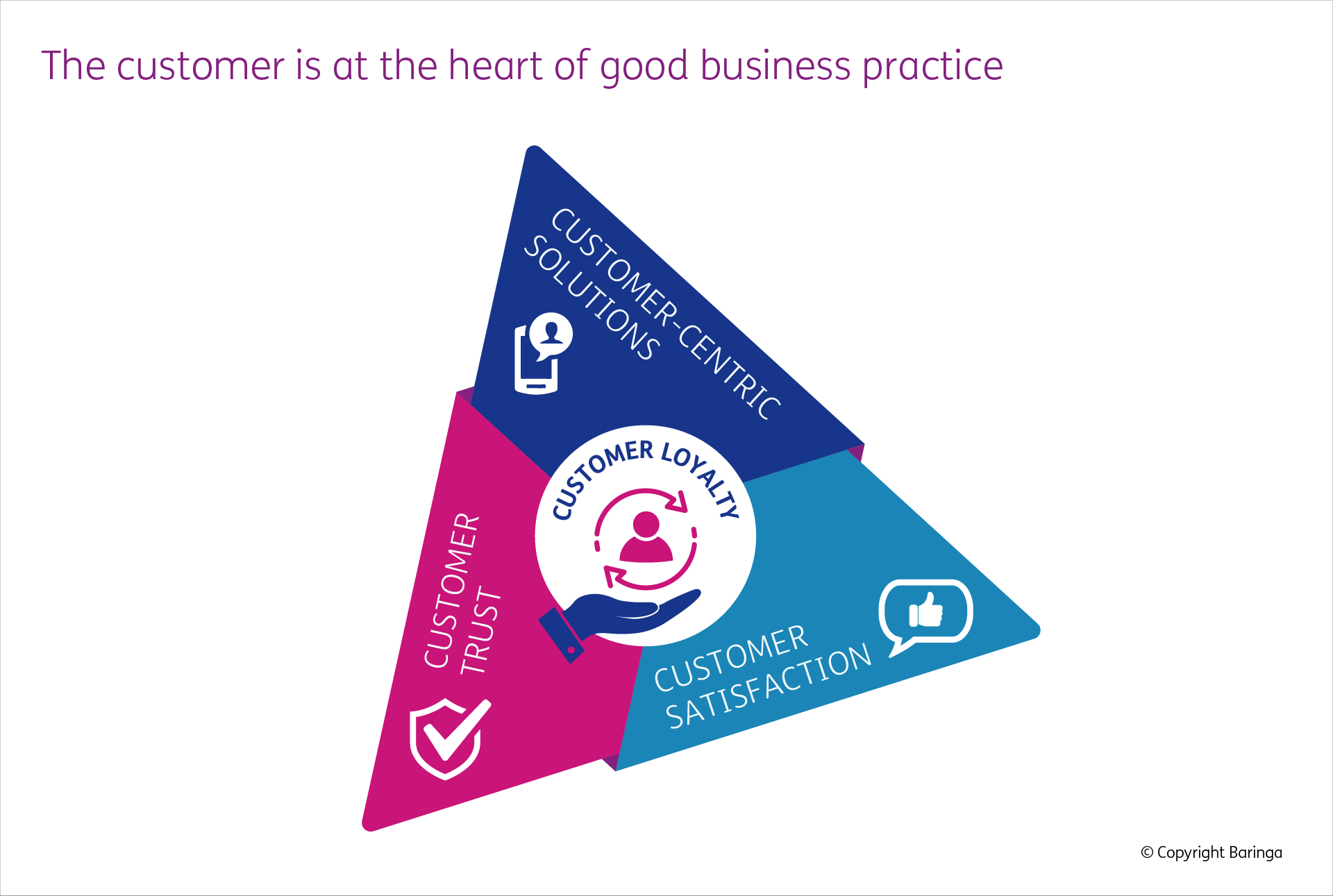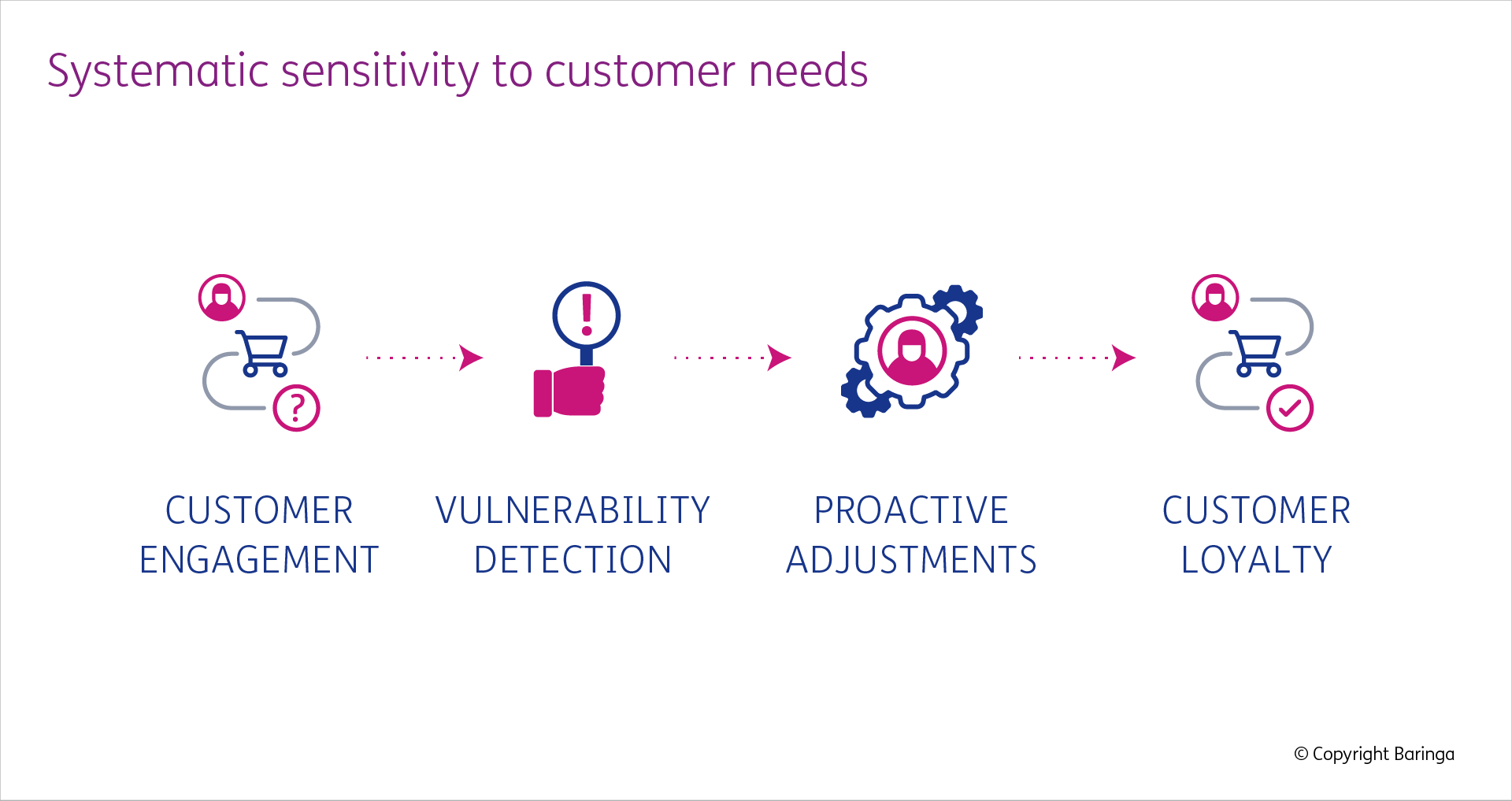As we have seen from our previous reports on financial vulnerability, many Britons are facing tough times ahead, with pressure on household finances rising across much of the country. Businesses should prepare to support their customers in managing this challenge.
We’re all on the same side
The rationale for a proactive management of your customers’ financial vulnerability is to acknowledge the simple fact that customers and the businesses they rely on are co-dependent. Creating a purpose-led customer-centric culture with solid mechanisms in place to understand who is struggling financially is good business as well as ethical practice. Those businesses that do it best will benefit most and will emerge as winners in the race for customer loyalty.

Proactive identification of customers in, or at risk of, financial vulnerability
Make self-disclosure easy
The first step is to identify those customers who may be financially vulnerable.
One of the most efficient ways to do this is to make it easy for people to tell you themselves about their financial position. Self-identification mechanisms could be online forms or eligibility calculators.
Considering the current outlook, many will be finding themselves with debt for the first time, therefore, equipping customers with the tools to support themselves, and avoid the stigma of debt, will be a key enabler to ensure all customer demographics are treated fairly.
The key to success here is being able to pair standard data points provided by customers with smart, automated analytical insights. This will enable businesses to immediately understand where customers sit on a spectrum of financial vulnerability and key financial risk indicators.
Use data to predict vulnerability and to tailor their experience
To further understand your financially vulnerable customers, both B2B and B2C businesses should be equipped to harness their data and build early warning indicator tools to predict and support those at different stages in their financial wellbeing. This view should be enriched by broader macro-economic and demographic information, data from external sources (such as third parties, strategic partners and open banking sources), and relevant data points from ongoing interactions with customers.
Early warning indicator tools should be the eyes and ears of the organisation; these insights enable you to better understand the profile of your customer, build a richer view of vulnerable customer ‘personas’ and create hyper-personalised journeys or products to support their specific needs.
Automate hyper-personalisation
An additional step would be to automate this hyper-personalisation of customer journeys by linking early warning detection mechanisms to logic designed to determine the best way to support the customer. Examples of this could be making changes to customer’s accounts or repayment plans without human intervention to prevent individuals and businesses from falling into debt. This example of automation would immediately benefit the customer and protect the business’ cost to serve.

A customer-led ethos to develop propositions and support mechanisms
Data is key to delivering customer-led service
Even without automation, it’s what businesses do with the data they’ve gathered that has the most critical influence over the customer experience. This needs to be the driver of what data is collected in the first place.
Being truly customer-led allows businesses to incorporate customer needs, from strategy through to design and delivery. Generally, businesses are relatively good at capturing customers' preferences and relevant personal information, but there is an opportunity to make better use of that information. By combining it with other data sources and feedback loops, inclusive journeys may be designed that address different needs, rather than the "one-size-fits-all" vulnerability journeys that are common across most sectors.
Ongoing customer engagement
Engaging with customers frequently enables businesses to be on the front foot when financially vulnerable customer needs are concerned. Investing in tools and techniques that provide customer feedback can provide qualitative information to support the design efforts within your products, services and operational teams. This might include speaking to customers about their current experience but should also include testing future concepts such as new, flexible payment options.
Agile and flexible response to rapidly changing circumstances
Agility to flex with rapidly changing needs
As noted in our previous articles, financial vulnerability is a fast-moving situation and people’s financial position can deteriorate quickly. To capture this, organisations need to go further than 'single point in time' assessments. Access to more data and information enables businesses to regularly monitor and act quickly in the best interest of their customers. For example, if bill repayments are being tracked over time, businesses can gain an understanding of the typical payment behaviour of that customer, which in turn can make it easier to spot changes that may require intervention. In order to drive this kind of decision, it is key to anonymise data sets based on cohort behaviours as this will build trust in the organisations and decisions.
Empower the front line
It’s also important that we consider customer service and the humans that support financially vulnerable customers in our contact channels. Mature organisations are equipping agents to be more agile and flexible when identifying and supporting customers in real-time. Voice and text analytics technology is being harnessed in telephone and chat conversations to indicate to the agent that this individual may be at risk of financial distress and, if the data is being used effectively, this can automatically equip the call handler with a relevant script for support.
Continuous listening to tailor service to customer needs
Even without the use of technology, combining internal data with constant customer and market engagement is key to being agile and flexible when responding to rapidly changing circumstances. The practice of continuously 'listening' to customers across interactions can enable you to make changes to customer journeys, optimise or include new channels, identify training gaps and create the right supporting processes.
Amplifying the impact through cross-sector approaches
Proactive identification, a customer-led ethos and agile and flexible responses all support the creation of better experiences and outcomes for your financially vulnerable customers.
For an individual business, this can be powerful, but people have outgoings in almost every sector. It is critical to look at the importance of organisations coming together to support customers and the wider community.
Becoming a “Considerate Company”
Certain sectors have discussed the concept of centralised data sharing within their industry. We believe such efforts could be broader and work across multiple sectors.
There is precedent in both private- and public-sectors for schemes that allow people to access certain services if they self-identify as vulnerable, but none have captured the public’s imagination or demonstrated a compelling proposition.
A carefully constructed and branded scheme focused solely on providing benefits to qualifying customers could provide a real advantage to both company and consumer.
As an example, a business could sign up to a ‘Considerate Company’ charter, perhaps by making certain principle-level commitments with regards to the treatment of certain customer types. In return, it would become part of a data-sharing network that allows it to construct and bundle products and services that are specifically tailored to more vulnerable customers – tailored offerings that might not be commercially-attractive for companies to provide otherwise.
Such an initiative could also dovetail with government schemes and support, enabling a more holistic approach to supporting financial vulnerability and delivering broader impact across the wider community.
The approach requires something of a conceptual and cultural flip from the twentieth century’s loyalty- and reward-card style programmes, which typically favoured wealthier customers. By contrast, a Considerate Company approach could mark the development of a more rounded and mature approach to segmented-customer offerings.
What's next?
There is no ‘silver bullet’ for supporting customers in financially vulnerable situations. However, businesses can go a long way in effectively identifying, understanding and supporting their customers by adopting a purpose-led, proactive and customer centric approach.
Businesses who actively cultivate such a culture and commit to supporting their financially vulnerable customers will better position themselves as partners for the long-term.
If you are interested in hearing more about how businesses can support their customers, please get in touch.
Get in touch with our experts
Caitlin Jones, Expert in Customer Experience Transformation
Kirsty Johnstone, Expert in Banking Customer Experience
Pablo Goldenberg, Expert in Customer Experience
Related Insights

Britain’s poorest face doubling of debt to energy suppliers
According to Baringa's figures, Britain’s poorest people now owe twice as much to energy suppliers as they did during the 2022 energy crisis.
Read more
Taking a person-centred approach to managing financial vulnerability
As Australia starts to feel the impact of rising energy bills, we share our view.
Read more
Safeguarding Financial Vulnerability
Growing numbers of customers, and businesses, are more financially vulnerable than ever.
Read more
Bringing the industry together to support customers
We share an overview of the challenges, solutions and success factors highlighted by our clients and industry partners around financial vulnerability
Read more